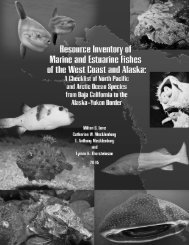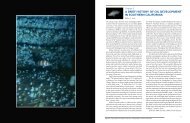Reproductive Ecology and Body Burden of Resident ... - The Love Lab
Reproductive Ecology and Body Burden of Resident ... - The Love Lab
Reproductive Ecology and Body Burden of Resident ... - The Love Lab
You also want an ePaper? Increase the reach of your titles
YUMPU automatically turns print PDFs into web optimized ePapers that Google loves.
TECHNICAL SUMMARY<br />
Study Title: <strong>Reproductive</strong> <strong>Ecology</strong> <strong>and</strong> <strong>Body</strong> <strong>Burden</strong> <strong>of</strong> <strong>Resident</strong> Fish Prior to Decommissioning<br />
Report Title: <strong>Reproductive</strong> <strong>Ecology</strong> <strong>and</strong> <strong>Body</strong> <strong>Burden</strong> <strong>of</strong> <strong>Resident</strong> Fish Prior to Decommissioning<br />
Contract Number: 1435-01-05-CA-39315<br />
Sponsoring OCS Region: Pacific<br />
Applicable Planning Area: Central <strong>and</strong> Southern California<br />
Fiscal Years <strong>of</strong> Project Funding: 2005-2009<br />
Completion Date <strong>of</strong> the Report: August 2009<br />
Costs: $535,000<br />
Cumulative Project Cost: $535,000<br />
Principal Investigators: Milton S. <strong>Love</strong>, Mary Nishimoto, Michael Saiki<br />
Key Words: oil platforms, platforms, California, decommissioning, platform decommissioning, reproduction,<br />
contaminants, heavy metals, Pacific s<strong>and</strong>dab, Citharichthys sordidus, otoliths, otolith microchemistry,<br />
kelp rockfish, Sebastes atrovirens, kelp bass, Paralabrax clathratus<br />
Background <strong>and</strong> Objectives:<br />
All <strong>of</strong> the 27 oil <strong>and</strong> gas platforms <strong>of</strong>f southern <strong>and</strong> central California have finite economic lives <strong>and</strong><br />
some may be nearing the end <strong>of</strong> that life span. Regarding platform disposition, there are a number <strong>of</strong> options,<br />
ranging from complete removal to some forms <strong>of</strong> structure retention. All options have effects on the<br />
lives <strong>of</strong> organisms living on <strong>and</strong> around these structures. <strong>The</strong> process by which decisions are made as to<br />
the disposition <strong>of</strong> these platforms is called decommissioning <strong>and</strong>, in federal waters, these decisions involve<br />
detailed environmental reviews by the MMS.<br />
Among the outst<strong>and</strong>ing questions still remaining is that <strong>of</strong> contamination <strong>and</strong> body burden in resident<br />
fishes residing around oil <strong>and</strong> gas platforms. <strong>The</strong> most common contaminants discharged at platforms are<br />
hydrocarbons <strong>and</strong> trace metals. For instance, given the recent mercury alarm concerning this element in<br />
organisms around Gulf <strong>of</strong> Mexico platforms <strong>and</strong> its potential harm to humans when concentrated in edible<br />
fishes, it is timely to determine what contaminants are in fishes that reside at Pacific platforms. However,<br />
the contaminant load in platform fishes must be seen against the background levels <strong>of</strong> fishes in the region.<br />
That is, the contaminants present in platform fishes must be compared to that <strong>of</strong> the fishes in nearby natural<br />
areas, in order to establish the relative importance <strong>of</strong> such contaminants to the region.<br />
Knowledge <strong>of</strong> the contaminant levels in platform-inhabiting fishes is <strong>of</strong> importance as it may affect<br />
reproduction. In order to analyze the environmental consequences <strong>of</strong> platform decommissioning on local or<br />
regional fish populations, the fate <strong>of</strong> young fishes recruiting to those populations <strong>and</strong> the general pollution<br />
load carried by fishes at platforms need to be known. This is especially true when the platforms are known to<br />
harbor large numbers <strong>of</strong> juveniles <strong>and</strong> resident reproducing adults <strong>of</strong> species that are regionally depleted by<br />
fishing <strong>and</strong> being considered for listing under the Endangered Species Act. Adults observed at the platform<br />
are reproductively mature <strong>and</strong> potentially produce larvae that ultimately replenish populations in natural<br />
areas. Adults, themselves, may migrate between platforms <strong>and</strong> natural areas. Any assessment <strong>of</strong> the impacts<br />
<strong>of</strong> platform removal on local <strong>and</strong> regional fish populations must consider the reproductive ecology <strong>of</strong> the<br />
species <strong>of</strong> interest, the general body burden <strong>of</strong> contaminants that the fish are carrying <strong>and</strong> their reproductive<br />
capability.<br />
Thus, the goal <strong>of</strong> this study was to fill gaps in information about the heavy metal body burden <strong>and</strong><br />
potential reproductive impairment <strong>of</strong> fishes living around oil <strong>and</strong> gas platforms. This goal was met through<br />
i




